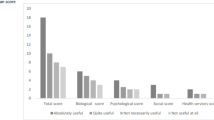Abstract
Objectives:A quality improvement process that will significantly increase the rate of identification of psychosocial problems through routine use of case-finding instruments can be established in a general medicine practice.
Design:Two groups of patient examination reports written by physicians were retrospectively compared with the patients’ responses on the case-finding database instrument. The samples were obtained by sequential selection in four time periods.
Setting and Patients:The study occurred in a university general internal medicine practice that utilizes the problem-oriented record. The patients studied were seen for first-time comprehensive examinations designed to identify all important bealth problems, including psychosocial problems.
Intervention:The authors compared performances of the physicians in identification of psychosocial problems before and after the intervention, which consisted of a pilot study audit of psychosocial problem identification, establishment of standards for interpretation of the case-finding instrument, design of a flow sheet to make case-finding data clearly available to the physician at each comprebensive examination, and feedback of physician performance according to practice-adopted standards for identification of psychosocial problems.
Measurement:The result of the intervention was an increase in psychosocial problem identification from 67% to 90% of problems present, p<0.05 by chi-square distribution; or a decrease from 33% to 10% in psychosocial problems missed by the physicians.
Conclusion:The quality improvement process for identification of psychosocial problems described in this report significantly increased the rate of identification of psychosocial problems by general internists.
Similar content being viewed by others
References
Good MD, Good BJ, Cleary PD. Do patient attitudes influence physician recognition of psychosocial problems in primary care? J Fam Pract. 1987;25:53–9.
Goldberg RJ. Depression in primary care: DSM-III diagnoses and other depressive syndromes. J Gen Intern Med. 1988;3:491–7.
Jones LR, Badger LW, Ficken RP, Leeper JD, Anderson RL. Inside the hidden mental health network: examining mental health care delivery of primary care physicians. Gen Hosp Psychiat. 1987;9:287–93.
Ashworth CD, Williamson P, Montano D. A scale to measure beliefs about psychosocial aspects of patient care. Soc Sci Med. 1984;19:1235–8.
Kessler LG, Cleary PD, Burke JD. Psychiatric disorders in primary care. Arch Gen Psychiat. 1985;42:583–7.
Von Korff M, Shapiro S, Burke JD, et al. Anxiety and depression in a primary care clinic. Arch Gen Psychiat. 1987;44:152–6.
Nielsen AC, Williams TA. Depression in ambulatory medical patients. Arch Gen Psychiat. 1980;37:999–1004.
Katon W, Kleinman A, Rosen G. Depression and somatization: a review. Part I. Am J Med. 1982;72:127–35.
Katon W, Kleinman A, Rosen G. Depression and somatization: a review. Part II. Am J Med. 1982;72:241–7.
Coulehan JL, Schulberg HC, Block MR. The efficiency of depression questionnaires for case finding in primary medical care. J Gen Intern Med. 1989;4:541–7.
Kamerow DB. Is screening for mental health problems worth-while in family practice? J Fam Pract. 1987;25:181–3.
Tufo HM. Beyond medical mystique—the system is the solution for obtaining patient participation.In Zurhellen JH, ed. Proceedings of the Fourth National Conference on Patient Education in the Primary Care Setting. Memphis: University of Tennessee, Department of Family Medicine, 1981;15–29.
Tufo H, Bouchard RE, Rubin AS, et al. Problem-oriented approach to practice. I. Economic impact. JAMA, 1977;238:414–7.
Tufo H, Bouchard RE, Rubin AS, Twitchell JC, VanBuren HC, Bedard L. Problem-oriented approach to practice. II. Development of the system through audit and implication. JAMA. 1977;238:502–5.
Tufo HM. Better patient care through self-assessment. Patient Care. 1980; Feb 15;182–98.
PROMIS III: adult medical history questionnaire for problem oriented practices. Princeton, NJ: Project Masters, Inc., 1982.
Okimoto JT. Screening for depression in geriatric medical patients. Am J Psychiat. 1982;139:799–802.
Hoffer A. Diagnosing depression. J Orthomolecular Psychiat. 1978;7:177–9.
Rhodes RH. A further look at the popoff index of depression. Psychol Rep. 1978;42;309–10.
Berndt SM, Berndt DJ, Byars WD. A multi-institutional study of depression in family practice. Fam Pract. 1983;16:83–7.
Holmes TH, Rahe RH. The social readjustment rating scale. J Psychosom Res. 1967;2:213.
Gropper M. Family medicine and psychosocial knowledge: how many hats can the family doctor wear? Soc Sci Med. 1987;25:1249–55.
Bouchard RE, Tufo HM, Beaty HN. The impact of a quality assurance program on postgraduate training in internal medicine. JAMA. 1985;253:1146–50.
Gerber PD, Barrett J, Barrett J, Manheimer E, Whiting R, Smith R. Recognition of depression by internists in primary care: a comparison of internist and “gold standard” psychiatric assessments. J Gen Intern Med. 1989;4:7–13.
Goldberg D, Steele JJ, Johnson A, Smith C. Ability of primary care physicians to make accurate ratings of psychiatric symptoms. Arch Gen Psychiat. 1982;39;829–33.
Marks JN, Goldberg DP, Hillier VF. Determinants of the ability of general practitioners to detect psychiatric illness. Psychol Med. 1979; 9:337–53.
Hase HD, Luger JA. Screening for psychosocial problems in primary care. J Fam Pract. 1988;26:297–302.
McDowell I. Screening for psychosocial problems among primary care patients: a pilot study. Can Med Assoc J. 1987;137:1095–100.
Author information
Authors and Affiliations
Rights and permissions
About this article
Cite this article
Bingham, R.L., Plante, D.A., Bronson, D.L. et al. Establishing a quality improvement process for identification of psychosocial problems in a primary care practice. J Gen Intern Med 5, 342–346 (1990). https://doi.org/10.1007/BF02600403
Issue Date:
DOI: https://doi.org/10.1007/BF02600403



